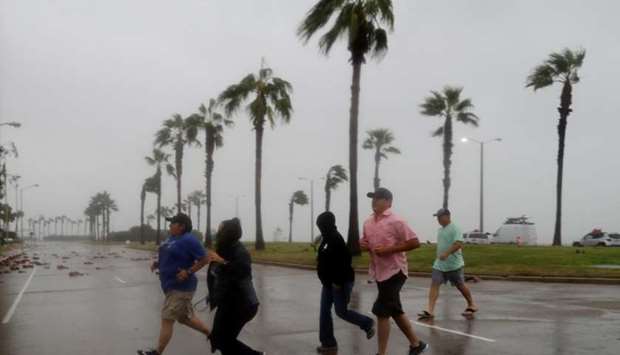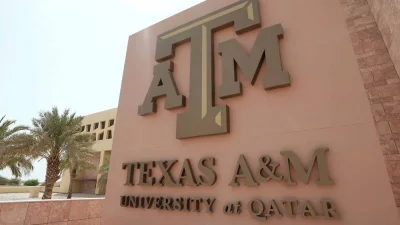* Residents flee most powerful storm on US mainland since 2005
* Residents told to take cover from wind, unprecedented flooding
* First Category 4 to hit Texas since Carla in 1961
Hurricane Harvey slammed into the Texas coast as a Category 4 storm on Friday, bringing life-threatening winds and the likelihood of catastrophic flooding as the most powerful storm in over a decade to hit the mainland United States.
The hurricane made landfall northeast of Corpus Christi around 10 p.m. CDT (0300 GMT) with maximum winds of 130 miles per hour (209 km per hour) and then, in a sign of its lumbering movement, made a second landfall nearby three hours later.
The storm is expected to move slowly over the Texas and Louisiana coasts for days, with forecasts for storm surges of up to 13 feet (4 meters) and over 3 feet (90 cm) of rain.
The town of Rockport appeared to be one of the hardest hit by Harvey's punch, hours after the mayor told anyone staying to write their names on their arms for identification in case of death or injury.
A high school, hotel, senior housing complex and other buildings suffered structural damage, according to emergency officials and local media. Some were being used as shelters.
"Right now we're still hunkered down and can't go anywhere," said Steve Sims, the volunteer fire chief in Rockport. "We've heard rumors of 1,000 different things, we can't confirm anything because we haven't seen anything. We know we've got a lot of problems, but we don't know what yet."
Sims said power, internet and most cell phone service was out in the town of 10,000 where about two-thirds of people evacuated. Most of the senior citizens and nursing homes were among the first to be evacuated, he said.
As many as 6 million people were believed to be in Harvey's path, as is the heart of America's oil refining operations. The storm's impact on refineries has already pushed up gasoline prices while the US Environmental Protection Agency lifted some rules on gasoline to reduce shortages.
Donald Trump, facing the first large-scale natural disaster of his presidency, said on Twitter he signed a disaster proclamation which "unleashes the full force of government help" shortly before Harvey made landfall.
Fueled by the warm waters in the Gulf of Mexico, Harvey became the first Category 4 hurricane to wallop the United States since Charley in 2004 and the first to hit Texas since Carla in 1961.
About 30 miles (45 km) from Corpus Christi and moving northwest, Harvey caused scattered power outages both on the coast near Galveston and 100 miles (160 km) inland.
"In the dark, internet out, ham radio not working. Is anybody out there? Alone trying not to be scared," Donna McClure in Corpus Christi said on Twitter as the storm made landfall.
As winds from the storm began to gust in Victoria, a downed powerline sparked a house fire, said the county sheriff's office. The mayor estimated some 65 percent of the town’s 65,000 residents defied the mandatory evacuation order.
While thousands fled the expected devastating flooding and destruction, many residents stayed put in imperiled towns and stocked up on food, fuel and sandbags, drawing the ire of authorities.
"We’re suggesting if people are going to stay here, mark their arm with a Sharpie pen with their name and Social Security number," Rockport Mayor Pro Tem Patrick Rios told reporters Friday, according to media reports. "We hate to talk about things like that. It's not something we like to do but it’s the reality. People don’t listen."
Houston prepares for floods
As a Category 4 hurricane on the Saffir-Simpson scale, Harvey could uproot trees, destroy homes and disrupt utilities for days. It is the first major hurricane, of Category 3 or more, to hit the mainland United States since Hurricane Wilma struck Florida in 2005.
Harvey's size and strength also dredged up memories of Katrina, the 2005 hurricane that made a direct hit on New Orleans as a Category 3 storm, causing levees and flood walls to fail in dozens of places. About 1,800 died in the disaster made worse by a slow government emergency response.
Corpus Christi, a city of 320,000, was under voluntary evacuation for Harvey. As the storm churned toward land, high winds rocked the few remaining cars circulating, littered streets palm tree debris and rocked sailboats in their docks.
Jose Rengel, a 47-year-old who works in construction, said he was one of the few people in Jamaica Beach in Galveston that did not heed a voluntary evacuation order.
"All the shops are empty,” he said as the sky turned black and rain fell. "It’s like a tornado went in and swept everything up.”
With the hurricane lashing the Texas coast, at least three cruise ships operated by Carnival Corp with thousands of passengers aboard were forced to change their plans to sail for the Port of Galveston.
Two of them headed New Orleans to pick up fresh supplies, while the third delayed its departure from Cozumel, Mexico.
Louisiana and Texas declared states of disaster, authorizing the use of state resources to prepare.
The NHC's latest tracking model shows the storm sitting southwest of Houston for more than a day, giving the nation's fourth most populous city a double dose of rain and wind.
The city warned residents of flooding from close to 20 inches (60 cm) of rain over several days.
Gasoline prices spike
Gasoline stations on the south Texas coast were running out of fuel residents fled the region. US gasoline prices spiked as the storm shut down 22 percent of Gulf of Mexico oil production, according to the US government.
More than 45 percent of the country's refining capacity is along the US Gulf Coast, and nearly a fifth of the nation's crude oil is produced offshore. Ports from Corpus Christi to Texas City, Texas, were closed to incoming vessels and Royal Dutch Shell Plc, Anadarko Petroleum Corp, Exxon Mobil Corp and others have evacuated staff from offshore oil and gas platforms.
Concern that Harvey could cause shortages in fuel supply drove benchmark gasoline prices to their highest in four months, before profit taking pulled back prices. Meanwhile, US gasoline margins <RBc1-CLc1> hit their strongest levels in five years for this time of year.
The US government said it would make emergency stockpiles of crude available if needed to plug disruptions. It has regularly used them to dampen the impact of previous storms on energy supplies.



